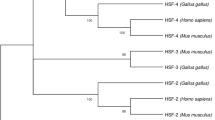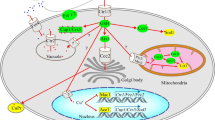Abstract
The heat shock factor (HSF), a protein evolutionarily conserved from yeasts to human, regulates the expression of a set of proteins called heat shock proteins (HSPs), many of which function as molecular chaperones. In Saccharomyces cerevisiae, the HSF binds to the 5′ upstream region of YGR146C and activates its transcription. YGR146C encodes a functional homolog of ecl1 +, ecl2 +, and ecl3 + of Schizosaccharomyces pombe. At present, these Ecl1 family genes, which are extenders of chronological lifespan, have been identified only in fungi groups. Based on ChIP analysis, we identified that Hsf1 binds to the upstream DNA region of ecl2 + after heat shock in S. pombe. In Caenorhabditis elegans, heat shock factor HSF-1 is known to regulate aging and required for the elongation of longevity by dietary restriction. We found that heat shock factor Hsf1 extends chronological lifespan of S. pombe when overexpressed. Moreover, we show that the extension of chronological lifespan by the overproduction of Hsf1 mainly depends on ecl2 + among Ecl1 family genes. From these results, we suggest that HSF is a conserved regulator of lifespan, at least in yeast and nematode, and Ecl1 family genes such as YGR146C and ecl2 + are the direct targets of Hsf1 and mediate lifespan extension by Hsf1.






Similar content being viewed by others
References
Azuma K, Ohtsuka H, Mita S, Murakami H, Aiba H (2009) Identification and characterization of an Ecl1-family gene in Saccharomyces cerevisiae. Biosci Biotechnol Biochem 73:2787–2789
Boehm M, Slack F (2005) A developmental timing microRNA and its target regulate life span in C. elegans. Science 310:1954–1957
Chen Q, Ding Q, Keller JN (2005) The stationary phase model of aging in yeast for the study of oxidative stress and age-related neurodegeneration. Biogerontology 6:1–13
Dardalhon M, Lin W, Nicolas A, Averbeck D (2007) Specific transcriptional responses induced by 8-methoxypsoralen and UVA in yeast. FEMS Yeast Res 7:866–878
Fabrizio P, Battistella L, Vardavas R, Gattazzo C, Liou LL, Diaspro A, Dossen JW, Gralla EB, Longo VD (2004) Superoxide is a mediator of an altruistic aging program in Saccharomyces cerevisiae. J Cell Biol 166:1055–1067
Fujita Y, Mita S, Ohtsuka H, Aiba H (2007) Identification of a fatty acyl-CoA synthetase gene, lcf2 +, which affects viability after entry into the stationary phase in Schizosaccharomyces pombe. Biosci Biotechnol Biochem 71:3041–3047
Gallo GJ, Schuetz TJ, Kingston RE (1991) Regulation of heat shock factor in Schizosaccharomyces pombe more closely resembles regulation in mammals than in Saccharomyces cerevisiae. Mol Cell Biol 11:281–288
Gallo GJ, Prentice H, Kingston RE (1993) Heat shock factor is required for growth at normal temperature in the fission yeast Schizosaccharomyces pombe. Mol Cell Biol 13:749–761
Gasch AP, Spellman PT, Kao CM, Carmel-Harel O, Eisen MB, Storz G, Botstein D, Brown PO (2000) Genomic expression programs in the response of yeast cells to environmental changes. Mol Biol Cell 11:4241–4257
Hahn JS, Hu Z, Thiele DJ, Iyer VR (2004) Genome-wide analysis of the biology of stress responses through heat shock transcription factor. Mol Cell Biol 24:5249–5256
Higuchi T, Watanabe Y, Yamamoto M (2002) Protein kinase A regulates sexual development and gluconeogenesis through phosphorylation of the Zn finger transcriptional activator Rst2p in fission yeast. Mol Cell Biol 22:1–11
Hsu AL, Murphy CT, Kenyon C (2003) Regulation of aging and age-related disease by DAF-16 and heat-shock factor. Science 300:1142–1145
Imazu H, Sakurai H (2005) Saccharomyces cerevisiae heat shock transcription factor regulates cell wall remodeling in response to heat shock. Eukaryot Cell 4:1050–1056
Krawchuk MD, Wahls WP (1999) High-efficiency gene targeting in Schizosaccharomyces pombe using a modular, PCR-based approach with long tracts of flanking homology. Yeast 15:1419–1427
Matsuyama A, Arai R, Yashiroda Y, Shirai A, Kamata A, Sekido S, Kobayashi Y, Hashimoto A, Hamamoto M, Hiraoka Y, Horinouchi S, Yoshida M (2006) ORFeome cloning and global analysis of protein localization in the fission yeast Schizosaccharomyces pombe. Nat Biotechnol 24:841–847
Ohtsuka H, Mita S, Ogawa Y, Azuma K, Ito H, Aiba H (2008) A novel gene, ecl1 +, extends the chronological lifespan in fission yeast. FEMS Yeast Res 8:520–530
Ohtsuka H, Ogawa Y, Mizuno H, Mita S, Aiba H (2009) Identification of ecl family genes that extend chronological lifespan in fission yeast. Biosci Biotechnol Biochem 73:885–889
Oshiro T, Aiba H, Mizuno T (2003) A defect in a fatty acyl-CoA synthetase gene, lcf1 +, results in a decrease in viability after entry into the stationary phase in fission yeast. Mol Genet Genomics 269:437–442
Parkes TL, Elia AJ, Dickinson D, Hilliker AJ, Phillips JP, Boulianne GL (1998) Extension of Drosophila lifespan by overexpression of human SOD1 in motorneurons. Nat Genet 19:171–174
Roux AE, Quissac A, Chartrand P, Ferbeyre G, Rokeach LA (2006) Regulation of chronological aging in Schizosaccharomyces pombe by the protein kinases Pka1 and Sck2. Aging Cell 5:345–357
Rutherford JC, Jaron S, Winge DR (2003) Aft1p and Aft2p mediate iron-responsive gene expression in yeast through related promoter elements. J Biol Chem 278:27636–27643
Sakurai H, Takemori Y (2007) Interaction between heat shock transcription factors (HSFs) and divergent binding sequences. J Biol Chem 282:13334–13341
Saltsman KA, Prentice HL, Kingston RE (1999) Mutations in the Schizosaccharomyces pombe heat shock factor that differentially affect responses to heat and cadmium stress. Mol Gen Genet 261:161–169
Schriner SE, Linford NJ, Martin GM, Treuting P, Ogburn CE, Emond M, Coskun PE, Ladiges W, Wolf N, Remmen HV, Wallace DC, Rabinovitch PS (2005) Extension of murine life span by overexpression of catalase targeted to mitochondria. Science 308:1909–1911
Steinkraus KA, Smith ED, Davis C, Carr D, Pendergrass WR, Sutphin GL, Kennedy BK, Kaeberlein M (2008) Dietary restriction suppresses proteotoxicity and enhances longevity by an hsf-1-dependent mechanism in Caenorhabditis elegans. Aging Cell 7:394–404
Voellmy R (2004) On mechanisms that control heat shock transcription factor activity in metazoan cells. Cell Stress Chaperones 9:122–133
Yamamoto A, Mizukami Y, Sakurai H (2005) Identification of a novel class of target genes and a novel type of binding sequence of heat shock transcription factor in Saccharomyces cerevisiae. J Biol Chem 280:11911–11919
Zimarino V, Tsai C, Wu C (1990) Complex modes of heat shock factor activation. Mol Cell Biol 10:752–759
Acknowledgments
We thank S. Mita for helpful discussions, M. Yamasaki for supports of statistical analyses, and Y. Miwa for critical reading of manuscript. This work was supported by a Grant-in-Aid for Scientific Research from the Ministry of Education, Culture, Sports, Science and Technology of Japan [to HA]. Part of this work was also supported by A Research for Promoting Technological Seeds from JST and Nagase Science and Technology Foundation [to HA], and by a grant from the Japan Society for the Promotion of Science for Young Scientists [to HO].
Author information
Authors and Affiliations
Corresponding author
Additional information
Communicated by T. Nyström.
Rights and permissions
About this article
Cite this article
Ohtsuka, H., Azuma, K., Murakami, H. et al. hsf1+ extends chronological lifespan through Ecl1 family genes in fission yeast. Mol Genet Genomics 285, 67–77 (2011). https://doi.org/10.1007/s00438-010-0588-6
Received:
Accepted:
Published:
Issue Date:
DOI: https://doi.org/10.1007/s00438-010-0588-6




